
Oscar Greeley Clendenning Hammerstein II was an American lyricist, librettist, theatrical producer, and director in musical theater for nearly 40 years. He won eight Tony Awards and two Academy Awards for Best Original Song. Many of his songs are standard repertoire for vocalists and jazz musicians. He co-wrote 850 songs.

Otto Abels Harbach, born Otto Abels Hauerbach was an American lyricist and librettist of nearly 50 musical comedies and operettas. Harbach collaborated as lyricist or librettist with many of the leading Broadway composers of the early 20th century, including Jerome Kern, Louis Hirsch, Herbert Stothart, Vincent Youmans, George Gershwin, and Sigmund Romberg. Harbach believed that music, lyrics, and story should be closely connected, and, as Oscar Hammerstein II's mentor, he encouraged Hammerstein to write musicals in this manner. Harbach is considered one of the first great Broadway lyricists, and he helped raise the status of the lyricist in an age more concerned with music, spectacle, and stars. Some of his more famous lyrics are "Smoke Gets in Your Eyes", "Indian Love Call" and "Cuddle up a Little Closer, Lovey Mine".
This is a list of notable events in music that took place in the year 1924.
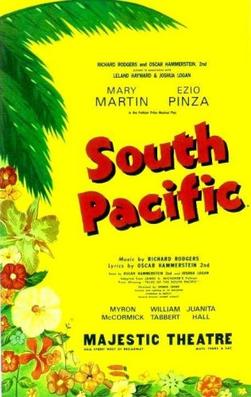
South Pacific is a musical composed by Richard Rodgers, with lyrics by Oscar Hammerstein II and book by Hammerstein and Joshua Logan. The work premiered in 1949 on Broadway and was an immediate hit, running for 1,925 performances. The plot is based on James A. Michener's Pulitzer Prize–winning 1947 book Tales of the South Pacific and combines elements of several of those stories. Rodgers and Hammerstein believed they could write a musical based on Michener's work that would be financially successful and, at the same time, send a strong progressive message on racism.

Rodgers and Hammerstein was a theater-writing team of composer Richard Rodgers (1902–1979) and lyricist-dramatist Oscar Hammerstein II (1895–1960), who together created a series of innovative and influential American musicals. Their musical theater writing partnership has been called the greatest of the 20th century.

Mary Ellis was an American actress and singer appearing on stage, radio, television and film, best known for her musical theatre roles, particularly in Ivor Novello works. After appearing with the Metropolitan Opera beginning in 1918, she acted on Broadway, creating the title role in Rose-Marie. In 1930, she emigrated to England, where she gained additional fame and continued to perform into the 1990s. She also became known for film roles, including in The 3 Worlds of Gulliver in 1960.

Jeanette Anna MacDonald was an American singer and actress best remembered for her musical films of the 1930s with Maurice Chevalier and Nelson Eddy. During the 1930s and 1940s she starred in 29 feature films, four nominated for Best Picture Oscars, and recorded extensively, earning three gold records. She later appeared in opera, concerts, radio, and television. MacDonald was one of the most influential sopranos of the 20th century, introducing opera to film-going audiences and inspiring a generation of singers.
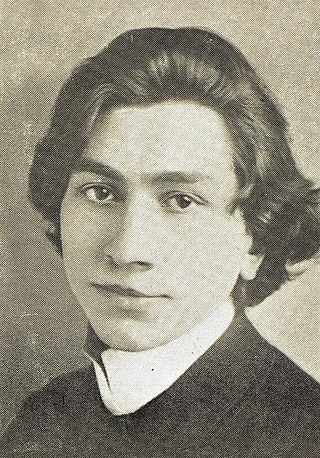
Charles Rudolf Friml was a Czech-born composer of operettas, musicals, songs and piano pieces, as well as a pianist. After musical training and a brief performing career in his native Prague, Friml moved to the United States, where he became a composer. His best-known works are Rose-Marie and The Vagabond King, each of which enjoyed success on Broadway and in London and were adapted for film.
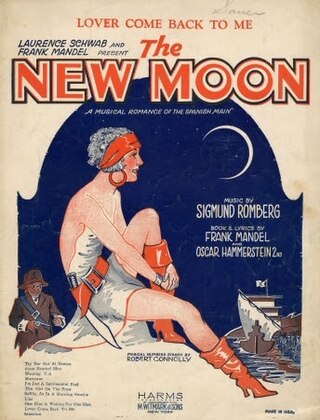
The New Moon is an operetta with music by Sigmund Romberg, lyrics by Oscar Hammerstein II and book by Oscar Hammerstein II, Frank Mandel, and Laurence Schwab. The show was the third in a string of Broadway hits for Romberg written in the style of Viennese operetta. Set in 1792, shortly before the French Revolution, the story centers on a young French aristocrat in disguise, who has fled his country and falls in love with the daughter of a prominent New Orleans planter.

Little Mary Sunshine is a musical that parodies old-fashioned operettas and musicals. The book, music, and lyrics are by Rick Besoyan. The original Off-Broadway production premiered November 18, 1959 at the Orpheum Theatre in New York City's East Village. Staying in the neighborhood, it moved to the Player's Theatre on June 21, 1961, then, finally, to the Cherry Lane Theatre on March 21, 1962. Closing was Sept. 2, 1962. Combined run was 1,143 performances. It was seen briefly in a West End production in 1962 and has become a popular show for amateur and semi-professional groups in the United States and elsewhere.
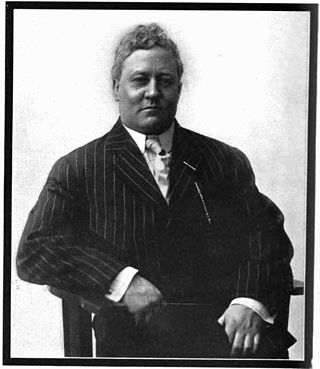
"Rose Marie" is a popular song from the musical or operetta of the same name. The music was written by Rudolf Friml and Herbert Stothart, the lyrics by Otto Harbach and Oscar Hammerstein II, In the original Broadway production in 1924, the song was performed by Dennis King and Arthur Deagon, as the characters Jim Kenyon and Sergeant Malone.
The Three Musketeers is a musical with a book by William Anthony McGuire, lyrics by Clifford Grey and P. G. Wodehouse, and music by Rudolf Friml. It is based on the classic 1844 novel by Alexandre Dumas, père. Set in France and England in 1626, it recounts the adventures of a young man named d'Artagnan after he leaves home to become a Musketeer of the Guard. The three men of the title are his friends Athos, Porthos and Aramis.
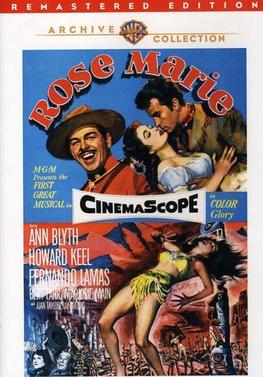
Rose Marie is a 1954 American musical western film adaptation of the 1924 operetta of the same name, the third to be filmed by Metro-Goldwyn-Mayer, following a 1928 silent movie and the best-known of the three, the 1936 Jeanette MacDonald-Nelson Eddy version. It is directed by Mervyn LeRoy and stars Ann Blyth, Howard Keel and Fernando Lamas. This version is filmed in the Canadian Rockies in CinemaScope. It was MGM's first US produced film in the new widescreen medium, and the first movie musical of any studio to be released in this format. It was part of a revival of large-budget operetta films produced in the mid-1950s.

The Firefly was the first operetta written by composer Rudolf Friml, with a libretto by Otto Harbach. The story concerns a young Italian girl, who is a street singer in New York. She disguises herself and serves as a cabin boy on a ship to Bermuda, where she falls in love. Complications arise, and eventually, she becomes a grand opera diva.
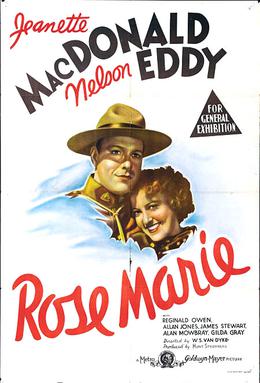
Rose Marie is a 1936 American musical Western film directed by W. S. Van Dyke and starring Jeanette MacDonald, Nelson Eddy and Reginald Owen. It is the second of three Metro-Goldwyn-Mayer film adaptations of the 1924 Broadway musical of the same name. A silent version was released in 1928 and a color film in 1954. All three versions are set in the Canadian wilderness. Portions of Rudolf Friml and Herbert Stothart's original score for the Broadway musical are included in both the 1936 and 1954 films.

"Indian Love Call" is a popular song from Rose-Marie, a 1924 operetta-style Broadway musical with music by Rudolf Friml and Herbert Stothart, and book and lyrics by Otto Harbach and Oscar Hammerstein II. Originally written for Mary Ellis, the song achieved continued popularity under other artists and has been called Friml's best-remembered work.

Rose-Marie is a 1928 American silent drama film directed by Lucien Hubbard. It was the first of three Metro-Goldwyn-Mayer adaptations of the 1924 operetta Broadway musical Rose-Marie. The best-known film adaptation starring Nelson Eddy and Jeanette MacDonald was released in 1936; another film was released in 1954. All three versions are set in the Canadian wilderness.
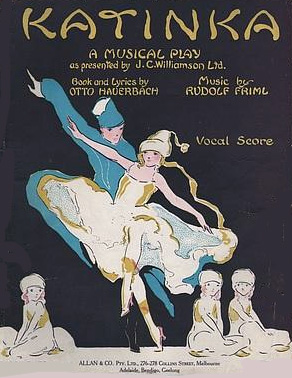
Katinka is an operetta in three acts composed by Rudolf Friml to a libretto by Otto Harbach. It was first performed at the Park Theatre in Morristown, New Jersey, on December 2, 1915, with May Naudain in the title role and subsequently received its Broadway premiere on December 23, 1915 at the 44th Street Theatre.

Wildflower or The Wildflower, is a musical in three acts with book and lyrics by Otto Harbach and Oscar Hammerstein II and music by Herbert Stothart and Vincent Youmans. The plot concerns a pretty Italian farmgirl, Nina, who has a fiery temper. She stands to inherit a fortune provided that she can keep her temper under control for six months. If she fails, the money goes to her cousin Bianca, who tries to provoke her. She manages to do it, and gets the money, as well as her man, Guido. Several of the songs were published, among which "Bambalina" and the title song were the most popular. The musical proved to be Day's last Broadway show before moving to London.
Nancy McCord was an American soprano and actress who had an active career in opera, musical theatre, and vaudeville during the 1920s, 1930s and early 1940s. She appeared in operettas and musicals on Broadway and in operas with several American companies, including the St. Louis Municipal Opera and the Metropolitan Opera. Her repertoire consisted mainly of roles from light opera and operettas. She is best remembered for creating the roles of Marie-Baroness von Schlewitz in the original production of Oscar Hammerstein II and Sigmund Romberg's May Wine (1935); and Mary Stone in the world premiere of Douglas Moore's The Devil and Daniel Webster (1939). She also performed leading roles in the United States premieres of two operettas: Franz Lehár's The Land of Smiles and Robert Stolz's Venus in Seide.

















